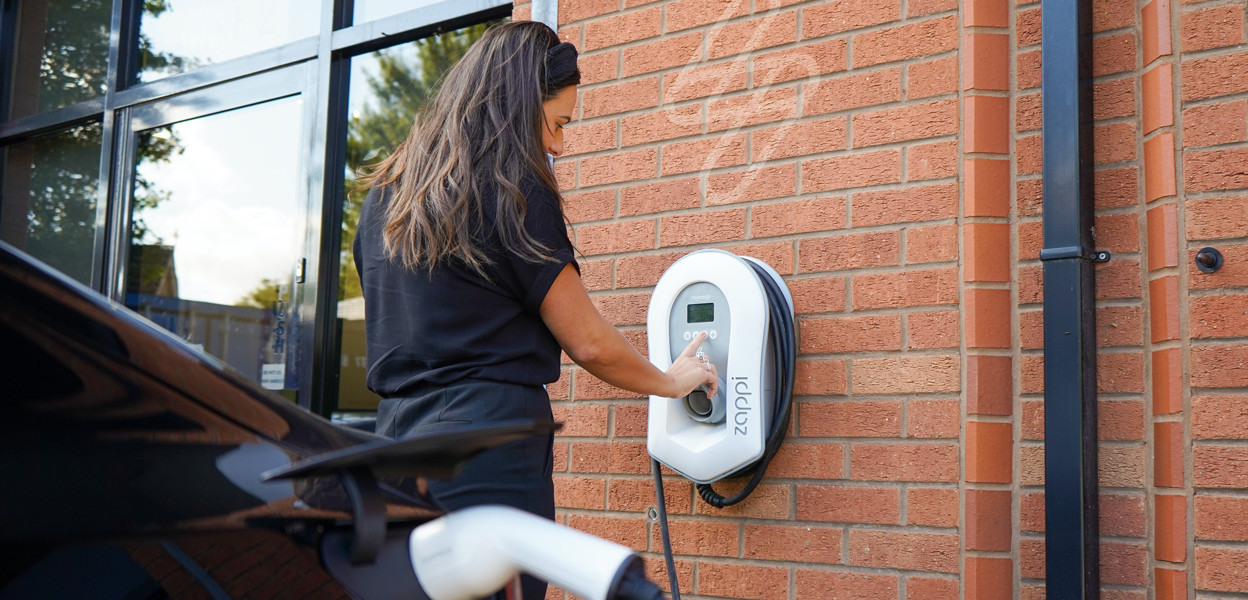- Combined Insurance


Electric Vehicles: Protecting Against the Risks
The change has been visible on the roads for several years: Electric vehicles, a novelty not so long ago, represent an increasing portion of the automobile traffic we encounter each day. In 2018 alone, the UK’s electric vehicle market grew 19 percent, comprising 59,700 new plug-in electric cars registered – and equating to one electric vehicle registered every nine minutes.(1) As of April 2021, there were more than 245,000 purely electric cars on UK roads (and over 515,000 models including plug-in hybrid vehicles).(2) Public charging points for electric vehicles outnumber petrol stations in the UK: There are currently more than 41,000 charging points across 15,000 UK locations.(3)
Considering the UK’s proposed ban on diesel and petrol vehicles by 2030, the presence of electric vehicles for both fleet and private use will only climb. And why not? As electric cars have continued to improve, the environmental and financial benefits of electric vehicles have become increasingly clear to the public. A traditional car running on an internal combustion engine has a 30 percent efficiency rate, while a vehicle running on electricity has an 80 percent efficiency rate. An electric car owner pays less for fuel, maintenance and tax. Consumers and businesses alike are ready to buy electric vehicles, and corporations and governments are providing incentives to encourage them. Still, any new technology generates new risks and challenges that must be understood and managed. Electric vehicles should be thought of not simply as traditional vehicles that must be plugged in, but as batteries on wheels. Most of the batteries running electric cars are lithium-ion (Liion) batteries, which are energy-dense yet lightweight, making it possible for manufacturers to provide a powerful charge in a small amount of space. Liion batteries are commonly found in a range of other portable electronics for these reasons – and they are considered safer than many other alternatives.
“One of the key benefits offered by lithium-ion batteries is that they have the best energy-to-weight ratios and increasing life cycles,” said Andrew Peacock, Senior Risk Control Account Consultant at Travelers Europe. “However, they tend to be less durable than other battery types and can be dangerous if damaged, over-charged, over-drawn, or otherwise mistreated.”
Liion batteries have generated high-profile losses due to potential safety hazards. Both the Samsung Galaxy Note 7 and Apple iPhone 6 have made news headlines due to consumer reports of Liion phone batteries exploding and catching fire. Automobile manufacturers including Ford, General Motors,
Hyundai, BMW and Tesla have all faced reports of vehicle fires related to the batteries and have had to initiate recalls and undergo safety investigations as a result. To be sure, such incidents are rare and lithium-ion technology is generally considered safer than other power sources. According to research from Tesla, gasoline-powered cars are about 11 times more likely to catch fire than a Tesla. In 2018, the company said Teslas had experienced five fires for every billion miles travelled, compared to a rate of 55 fires per billion miles travelled for gasoline-powered cars. As with anything we incorporate into our daily lives – particularly new technology – it’s important to understand the hazards electric vehicles bring, as well as that we can do to minimise them and improve the likelihood of a safe experience.
Understanding the hazards
Since Liion batteries have been the source of the highest-profile losses the electric vehicle industry has faced, it makes sense to examine how the batteries generate risks. Liion vehicle batteries are made of many smaller cylindrical or prismatic cells that are linked together to meet the required power capacity. A cell is made from an outer case (normally metal) with a hole that releases excess pressure in the event of overheating. Inside the case is a spiral that consists of three thin layered sheets – the positive cathode, the negative anode and a thin sheet of microperforated plastic separating the two. This layered spiral is submerged in an organic electrolyte. When the cell is charging, Lithium ions move through the electrolyte from the positive electrode to the negative and they do the reverse when discharging. The greater the power a vehicle needs, the more cells that are required for it to operate. It isn’t unusual for a family’s electric car to contain many hundreds of cells, while a heavy-goods vehicle could easily contain thousands. Manufacturers and insurers must consider a number of risks associated with these batteries, including battery runaway, normally occurring vehicle damage or poor handling of cells during maintenance, fires related to charging areas, and slips, trips and falls caused by trailing cables.
Runaway
The term thermal runaway refers to an unstoppable exothermic (heat-producing) reaction. This occurs when a Liion battery is damaged or exposed to significant heat. During the runaway, the temperature of the battery cells climbs rapidly, causing the cells in the battery to break down and release flammable gases, which, in turn, create the risk of fire and explosion. Once the cell ignites, it produces oxygen and hydrogen, further fuelling the exothermic reaction. This is of particular concern in vehicles because once the thermal runaway is underway, it becomes difficult to fight the fire. The intense heat exposes the remaining cells in the batteries, igniting them and exposing additional cells to the heat. Extinguishing this fire poses additional challenges. While water will reduce the temperature of the battery, the exposure of lithium to water generates hydrogen, which is highly flammable and, in turn, further increases the intensity of the fire. This proved true when a 2019 Tesla Model S battery caught fire, causing firefighters to spend four hours and more than 136,000 litres of water trying to extinguish a blaze that would have otherwise been contained in minutes.(5) When this kind of fire occurs in an enclosed space underground or in a carpark, the intensity of its heat can cause it to spread quickly and become all the more difficult to control.
Several factors can lead to thermal runaway and most relate to misuse or mishandling of the battery. Exposure to excessive heat could cause the cell separators to melt, releasing flammable gases. A puncture or other form of impact could crush or deform cells and lead to an internal short circuit. Excessive charging could stress the battery, while too little charge can short-circuit the battery, triggering a thermal runaway. Manufacturing defects could also lead to problems. To minimise these risks, it’s important to store batteries properly, shield them from heat sources and physically protect batteries in use – especially those in fleet vehicles. Using them within warranty conditions and disposing of batteries in a timely way with licensed contractors is critical too.
Charging areas
As the number of electric vehicle charging points climbs across the UK, they must be safely integrated into supporting construction – both new and existing. Designated public or work charging points should be fit for purpose. Further, a fire risk assessment should identify intelligent detection and alarm systems wherever electric vehicles are parked and charged in large numbers as damage to one can quickly spread to many. Indeed, when a van at an outdoor charging point in China caught fire recently, it spread rapidly and severely damaged several other vehicles being charged nearby.(6) Businesses that operate public charging points have a range of risk mitigation factors to consider. They must ensure the layout of the charging area reduces the risk of possible impact or collision. Charging of vehicles should happen away from main entry and exit points, as well as any high-traffic routes. Any vehicle-charging interface should be protected using crash barriers, signage and suitable separation distances to reduce the speed of a collision, along with the potential for one. Charging locations must be separated from any combustible materials and periodic checks must be carried out to protect safety. The same risk management principles apply to domestic and street-side charging locations, with some additional factors to consider. These locations should not use domestic multi-socket extension leads when charging. The same is true for daisy-chain extension leads, which increase the risk of an electrical fire. If extension leads are needed, a suitable outdoor reel cable must be used. Charging cables should be purchased from reputable retailers or the manufacturer and meet UK safety standards (CE). They should be checked regularly and replaced if any damage is apparent. Charging should be done within a fire-sterile area and from a dedicated wall box charging unit installed by a licensed electrician.
Slips, trips, falls and Professional Liability exposure
When conceiving of the best cover for a charging location, consider the likely activity surrounding the area in order to limit potential hazards. It is possible that public charging areas may attract more foot traffic, for example, and will need to be inspected to minimise slips, trips and falls due to potholes, obstructed pathways, poor lighting, unkempt vegetation, snow or ice. At street-side charging areas, owners should avoid having cables cross pavements or walkways – or manage them as well as possible by using shorter cable lengths or cable covers.
Putting risks into perspective
The early years and decades of any life-changing innovation require careful study and adjustment. While gasoline-powered cars became widely available in the early 20th century, it wasn’t until the late 1920s when the automobile industry acknowledged the need for such safety measures as shatter-resistant windscreens and four-wheel brakes. When you understand the hazards, you can design better protections around them until new-and-improved replacements are available. For those purchasing electric vehicles for personal or fleet use, that means knowing the risks of Liion batteries, caring for them properly, and limiting the potential for accidents that can pose safety and financial threats.
As electric vehicles expand their presence in both households and fleets, it’s important to have a clear-eyed perspective on lithium-ion batteries so we can manage the risks they pose,” said Peacock. “Only then can we maximise their benefits.”
1 https://www.goultralow.com/news/one-every-nine-minutes-60000-electric-cars-registered-in-2018-marking-7th-consecutive-year-of-growth/.
2 https://www.nextgreencar.com/electric-cars/statistics/#:~:text=How%20many%20electric%20vehicles%20have,BEVs%20and%20270%2C000%20PHEVs%20registered.
3 https://www.zap-map.com/statistics/
4 https://www.bbc.co.uk/news/business-38714461, https://appleinsider.com/articles/21/05/06/man-sues-apple-for-iphone-6-battery-explosion-caused-by-alleged-defect
5 https://www.forbes.com/sites/roberthart/2021/04/19/houston-tesla-crash-underscores-how-little-is-known-about-the-nature-of-car-battery-fires–and-why-they-burn-forhours/?sh=28413f376c6e.
6 https://insideevs.com/news/423581/severe-electric-car-fire-explosion-charging/.
The Knowledge Newsletter
Subscribe to The Knowledge for a no-nonsense view into the latest research and trends before it makes its way to our blog.
We will only use your email address to send you this newsletter. You can unsubscribe at any time. Privacy Policy













